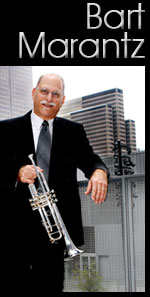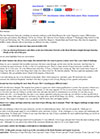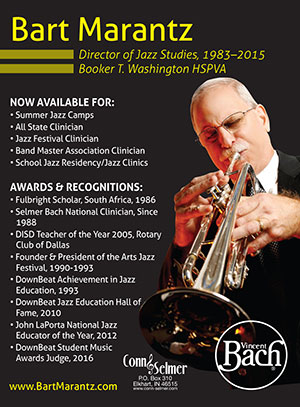 Home B.M.P. BTWHSPVA Articles Interviews Reviews Books Biography Videos Photos Calendar Music Links Contact Sara Marantz Matt Marantz Luke Marantz
Bart Marantz NPR/KERA Jazz Education Interview    Click below to listen to the interview  Click below to read the article 
|
Reviews "Blues For Bubber" Composed and Arranged By: Kevin McElrath Instrumentation: Big Band Publisher: KJOS Neil A. Kjos Music Company Grade 3 1/2 Swing Tempo = 112 $45.00 “Blues For Bubber” is a tribute to the sound of the early Duke Ellington orchestra from about 1928 to 1932. During this period a trumpet player on the band named “Bubber” Miley, originated the “low down,” growling style of trumpet playing. The most famous example of Miley’s playing can be heard in the original 1928 recording of “East St. Louis Toodle-00,” which Ellington co-composed with Miley. Other fine examples of Miley’s unique style can be heard in the original recordings of “The Mooche” and “Black and Tan Fantasy,” both recorded in 1929. The early Ellington band also featured alto saxophonist Johnny Hodges, who would remain with the band for many years. Though not represented in the title, “Blues for Bubber” also pays tribute to Hodges, unique style. The alto saxophone solo starting at measure 77 should be played in a very clear, “cantabile” style. The director and soloist should refer to “The Mooche” and the 1932 recording of “ It Don’t mean a Thing” to hear some fine examples of Johnny Hodges’ “sing-song” style playing. This piece should be played with a very strong time feel. It is suggested by the composer that if a four-string “plectrum” banjo is available, feel free to use it in place of guitar to give more dynamic rhythmic force and greater authenticity to the piece. Remember this is a period piece and the band as well as the director should do listening together of the Ellington band before attempting this fine original. If the banjo is used, sustained chords should be played tremelo, using a wide open sound with vibrato. Refer to Duke Ellington's “stride piano feel of the 1929 original recording of “Black and Tan Fantasy.” Top note for trumpet Bb above the staff Bart Marantz |


